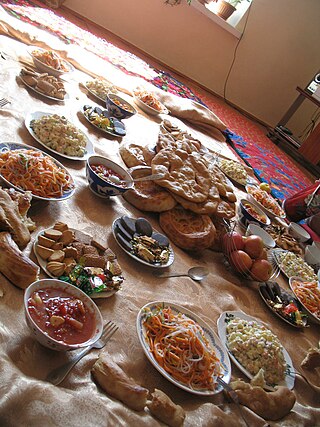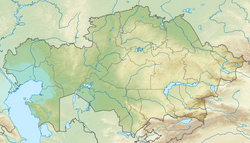Crops and domesticated animals
Direct AMS dating of broomcorn millet and wheat seeds from Begash date to around 2460-2150 BC. Most of the seeds were recovered from cist burials, with very few seeds being recovered from hearths. As almost all of the seeds came from burial contexts, the domesticated wheat and millet was most likely primarily used only for ritual purposes.
Free threshing wheat, either Triticum aestivum or Triticum turgidum , and broomcorn millet were found in all of the cultural layers at Begash.
The early wheat seeds from Begash were small, compact and round. The seeds are morphologically similar to modern Indian dwarf wheat and were similar to the seeds found in early China. The domesticated grains at Begash were not cultivated locally and were likely obtained through trade. Located near the Dzungarian Alatau, Begash is situated along the way on what is described as the "wheat road", a route of likely transmission of wheat and other goods from Western Asia to China.
The people of Begash relied mostly on herding, supplemented by limited hunting. The people of Begash herded sheep, goats, cattle, and horses and hunted red deer, goitered gazelle, Siberian ibex, and Argali.
Most of the animal remains at Begash came from domesticated animals. Starting from the earliest period at Begash, sheep and goat remains were found most frequently, and remained the primary animal remains found at Begash throughout its entire history. Over time, cattle slowly began to increase and eventually became the third most commonly found domesticated animal remains at Begash. Surprisingly, the presence of horse remains remained rather low at Begash throughout its history, although the presence of horse remains did gradually increase over time, especially from the Iron Age onwards.
The people of Begash likely burned dung as fuel.

Mehrgarh is a Neolithic archaeological site situated on the Kacchi Plain of Balochistan in Pakistan. It is located near the Bolan Pass, to the west of the Indus River and between the modern-day Pakistani cities of Quetta, Kalat and Sibi. The site was discovered in 1974 by an archaeological team led by the French archaeologists Jean-François Jarrige and his wife, Catherine Jarrige. Mehrgarh was excavated continuously between 1974 and 1986, and again from 1997 to 2000. Archaeological material has been found in six mounds, and about 32,000 artifacts have been collected from the site. The earliest settlement at Mehrgarh—located in the northeast corner of the 495-acre (2.00 km2) site—was a small farming village dated between 7000 BCE and 5500 BCE.

The Neolithic period, or New Stone Age, is an Old World archaeological period and the final division of the Stone Age. It saw the Neolithic Revolution, a wide-ranging set of developments that appear to have arisen independently in several parts of the world. This "Neolithic package" included the introduction of farming, domestication of animals, and change from a hunter-gatherer lifestyle to one of settlement.

The 9th millennium BC spanned the years 9000 BC to 8001 BC. In chronological terms, it is the first full millennium of the current Holocene epoch that is generally reckoned to have begun by 9700 BC. It is impossible to precisely date events that happened around the time of this millennium and all dates mentioned here are estimates mostly based on geological and anthropological analysis, or by radiometric dating.

The Neolithic Revolution, or the (First) Agricultural Revolution, was the wide-scale transition of many human cultures during the Neolithic period from a lifestyle of hunting and gathering to one of agriculture and settlement, making an increasingly large population possible. These settled communities permitted humans to observe and experiment with plants, learning how they grew and developed. This new knowledge led to the domestication of plants into crops.

The Longshanculture, also sometimes referred to as the Black Pottery Culture, was a late Neolithic culture in the middle and lower Yellow River valley areas of northern China from about 3000 to 1900 BC. The first archaeological find of this culture took place at the Chengziya Archaeological Site in 1928, with the first excavations in 1930 and 1931. The culture is named after the nearby modern town of Longshan in Zhangqiu, Shandong. The culture was noted for its highly polished black pottery. The population expanded dramatically during the 3rd millennium BC, with many settlements having rammed earth walls. It decreased in most areas around 2000 BC until the central area evolved into the Bronze Age Erlitou culture. The Longshan culture has been linked to the early Sinitic . According to the area and cultural type, the Longshan culture can be divided into two types: Shandong Longshan and Henan Longshan. Among them, Shandong Longshan Cultural Site includes Chengziya Site; Henan Longshan Cultural Site includes Dengfeng Wangchenggang Site in Wangwan, Taosi Site and Mengzhuang Site in Hougang.

The Dawenkou culture was a Chinese Neolithic culture primarily located in the eastern province of Shandong, but also appearing in Anhui, Henan and Jiangsu. The culture existed from 4300 to 2600 BC, and co-existed with the Yangshao culture. Turquoise, jade and ivory artefacts are commonly found at Dawenkou sites. The earliest examples of alligator drums appear at Dawenkou sites. Neolithic signs, perhaps related to subsequent scripts, such as those of the Shang dynasty, have been found on Dawenkou pottery.

Qasr Ibrim is an archaeological site in Lower Nubia, located in the modern country of Egypt. The site has a long history of occupation, ranging from as early as the eighth century BC to AD 1813, and was an economic, political, and religious center. Originally it was a major city perched on a cliff above the Nile, but the flooding of Lake Nasser after the construction of the Aswan High Dam – with the related International Campaign to Save the Monuments of Nubia – transformed it into an island and flooded its outskirts. Qasr Ibrim is the only major archaeological site in Lower Nubia to have survived the Aswan Dam floods. Both prior to and after the floods, it has remained a major site for archaeological investigations.
Uan Muhuggiag is an archaeological site in Libya. It was occupied by pastoralists during the early- to mid-Holocene. The site is where the Tashwinat Mummy was found, which was dated to around 5600 BP. It now resides in the Assaraya Alhamra Museum in Tripoli.
Nomadic pastoralism is a form of pastoralism in which livestock are herded in order to seek for fresh pastures on which to graze. True nomads follow an irregular pattern of movement, in contrast with transhumance, where seasonal pastures are fixed. However, this distinction is often not observed and the term 'nomad' used for both—and in historical cases the regularity of movements is often unknown in any case. The herded livestock include cattle, water buffalo, yaks, llamas, sheep, goats, reindeer, horses, donkeys or camels, or mixtures of species. Nomadic pastoralism is commonly practised in regions with little arable land, typically in the developing world, especially in the steppe lands north of the agricultural zone of Eurasia.

Central Asian cuisine has been influenced by Persian, Indian, Arab, Turkish, Chinese, Mongol, African, and Russian cultures, as well as the culinary traditions of other varied nomadic and sedentary civilizations. Contributing to the culinary diversity were the migrations of Uyghur, Slav, Korean, Tatar, Dungan and German people to the region.

The Houli culture was a Neolithic culture in Shandong, China. The people of the culture lived in square, semi-subterranean houses. The most commonly found artefacts at Houli sites are pottery and stone tools. Jade artefacts and bone, antler, shell tools were also found at Houli sites. While the remains of domesticated dogs and pigs in the early stages of domestication were found at some sites associated with the culture, the people of the Houli culture relied mostly on hunting and fishing. The remains of rice, broomcorn millet, and foxtail millet were discovered at Houli sites.

The Prehistory of Siberia is marked by several archaeologically distinct cultures. In the Chalcolithic, the cultures of western and southern Siberia were pastoralists, while the eastern taiga and the tundra were dominated by hunter-gatherers until the Late Middle Ages and even beyond. Substantial changes in society, economics and art indicate the development of nomadism in the Central Asian steppes in the first millennium BC.

Sarazm is an ancient town and also a jamoat in north-western Tajikistan. It dates back to the 4th millennium BC and is today a UNESCO World Heritage Site. The jamoat is part of the city of Panjakent in Sughd Region, and has a total population of 27,877 (2015). It consists of 21 villages, including Chimqal'a, Abdusamad, Bostondeh, Kamar, Kamar-Tash and Sohibnazar.
The Knovíz culture was an upper Danubian subgroup of the Late Bronze Age Urnfield culture, located mainly in Bohemia, Thuringia, and Bavaria. The eponymous type site for this culture, the Czech village of Knovíz, is located around 25 kilometres (16 mi) northwest of Prague. The Knovíz culture was similar to the neighbouring Milavce culture, except for the funerary rites, which featured occasional skeletal burials as well as cremations.
Dhar Tichitt is a Neolithic archaeological site located in the southwestern region of the Sahara Desert, in Mauritania. It is one of several settlement locations along the sandstone cliffs in the area. Dhar Tichitt, Dhar Walata, Dhar Néma, and Dhar Tagant are the sites which compose Tichitt culture. The cliffs were inhabited by farmers and pastoralists starting at around 4500 BP and lasted to around 2300 BP, or approximately 2500 to 500 BCE. This area is one of the oldest known archaeological occupation sites in the western part of Africa. About 500 stone settlements littered the region in the former savannah of the Sahara. In addition to herding livestock, its inhabitants hunted, fished, collected wild grain, and grew bulrush millet. The inhabitants and creators of these settlements during these periods thought to have been ancestors of the Soninke people.

The Pastoral Neolithic refers to a period in Africa's prehistory, specifically Tanzania and Kenya, marking the beginning of food production, livestock domestication, and pottery use in the region following the Later Stone Age. The exact dates of this time period remain inexact, but early Pastoral Neolithic sites support the beginning of herding by 5000 BP. In contrast to the Neolithic in other parts of the world, which saw the development of farming societies, the first form of African food production was nomadic pastoralism, or ways of life centered on the herding and management of livestock. The shift from hunting to food production relied on livestock that had been domesticated outside of East Africa, especially North Africa. This period marks the emergence of the forms of pastoralism that are still present. The reliance on livestock herding marks the deviation from hunting-gathering but precedes major agricultural development. The exact movement tendencies of Neolithic pastoralists are not completely understood.
Xishanping is an archaeological site in Gansu, China, located 15 km (9 mi) west of Tianshui. The site was occupied continuously from the Neolithic through the Bronze Age. The site is situated about 50 m (160 ft) above the riverbed on the southern bank of the Xi River, a tributary of the Wei River. The site was discovered by Pei Wenzhong in 1947.
Xinglonggou is a Neolithic through Bronze Age archaeological site complex consisting of three separate sites. The sites are located on a loess slope above the left bank of the Mangniu River north of the Qilaotu Mountains in Aohan Banner, Inner Mongolia, China. Xinglonggou is one of the most important sites of the early Neolithic Xinglongwa culture and provides evidence for the development of millet cultivation. The millet assemblage at Xinglonggou consists primarily of broomcorn millet. Xinglonggou is one of the few, early Neolithic sites in China for which systematic flotation has been performed.
Xituanshan is a Late Bronze Age group of stone burials in Jilin, China. It was designated a Major National Historical and Cultural Site by the Chinese government in 2001.
The Inner Asian Mountain Corridor (IAMC) was an ancient exchange route ranging from the Altai Mountains in Siberia to the Hindu Kush, which took shape in the 3rd millennium BCE. The expansion of the Indo-European Andronovo culture towards the Bactria-Margiana Culture in the second millennium BCE took place along the IAMC, giving way to the Indo-Aryan migration into South Asia.













